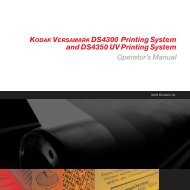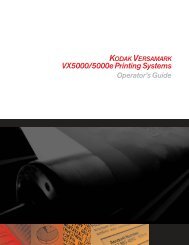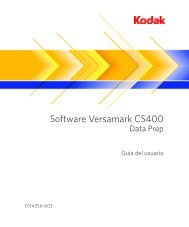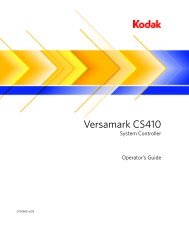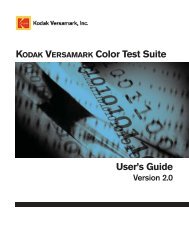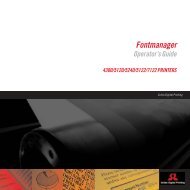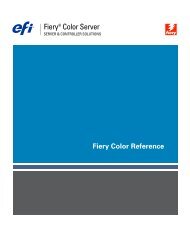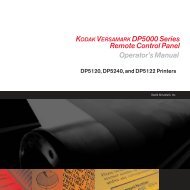Chapter 1. Color Management Background - Kodak
Chapter 1. Color Management Background - Kodak
Chapter 1. Color Management Background - Kodak
You also want an ePaper? Increase the reach of your titles
YUMPU automatically turns print PDFs into web optimized ePapers that Google loves.
<strong>Chapter</strong> 2. Using <strong>Color</strong>Wise Pro Tools<br />
Output Profile Creation<br />
correct the data back to the state of the press when the ICC profile<br />
was created. This window will display what Calibration Set your<br />
output profile belongs to. It also shows the Ink Limit of the Set. If you<br />
have any data in your file above the percentage listed here, it will be<br />
reduced 4 dimensionally to that percentage by EFI’s Ink Reduction<br />
Algorithm. As a reminder, calibration will only operate on one color<br />
plane at a time, so these curves will not result in any pollution of the<br />
primaries.<br />
10. The final option for the data is to choose if you want your black text<br />
and/or line art graphics to overprint any background or knockout. See<br />
page 2-21 for more information on the Black Overprint.<br />
SIMULATION MODE<br />
This workflow has a second path it could possibly take and that is to first<br />
convert the RGB data into the gamut of another digital printer or press<br />
standard and then into the color space of the <strong>Kodak</strong> Versamark Press on<br />
a given paper. The CMYK data would follow the same path as described<br />
above. This feature is helpful for making one type of output device behave<br />
like different output device.<br />
For this workflow, check the box labeled Simulation underneath the<br />
Rendering Intent drop-down menu. The arrows in the Expert <strong>Color</strong><br />
Settings window will update to show the new data path. RGB data will<br />
now be converted to the CMYK Simulation color space first, and then to<br />
the output profile color space you have selected.<br />
Data then follows the same path as described in the first part of this<br />
section.<br />
Output Profile Creation<br />
There are four major steps in creating an Output Profile for your press.<br />
They are:<br />
1 Print the Calibration Pattern and Linearization Page<br />
2 Determine the maximum ink for the paper.<br />
3 Print an ICC Pattern using the results of the Calibration Pattern.<br />
4 Use a utility to create an ICC Profile from the ICC Pattern.<br />
This will go over these three major steps and all the minor steps in<br />
between.<br />
1 Print the Calibration Pattern & Linearization Page<br />
The Calibration Pattern needs to be printed on the press with NO<br />
ICC, NO linearization and NO Calibration adjustment. Once<br />
printed, the Calibrator tool from <strong>Color</strong>Wise Pro Tools will be used<br />
to read in the data.<br />
<strong>1.</strong>1 Go to the main CWS window and choose File→ Import → Job.<br />
Navigate to the correct directory. Select the Cal&Lin.pdf file and<br />
click Add then Import (be sure Logical Printer is set to CS600<br />
hold). The job will spool and then drop into a held state on the<br />
server.<br />
<strong>Color</strong> <strong>Management</strong> and Workflow User Guide 2 - 25



